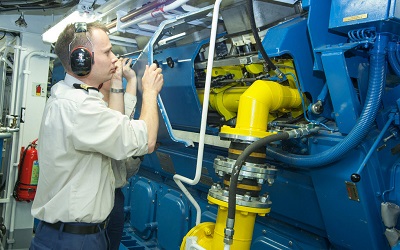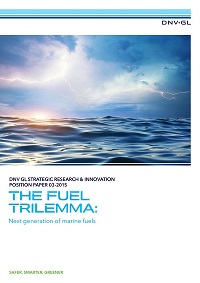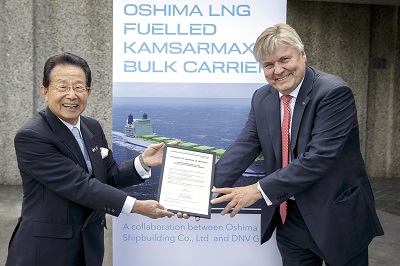Engines, Fuels and Efficiency at Nor-Shipping
Nor-Shipping has seen a strong focus on technical developments to support improved energy efficiency and emissions reductions. MarEx highlights some of the latest developments unveiled at the event:
New Permanent Magnet Azimuth Thruster
Rolls-Royce has unveiled the latest addition to its range of marine thrusters, with the launch of a new azimuth thruster powered by permanent magnet (PM) technology. The new thruster is the group’s latest development of PM technology, which already includes tunnel thrusters and a newly developed winch.
.jpg) The launch follows a programme of sea trials in which a pair of thrusters demonstrated efficiency savings of 7-13 percent depending on ship speed, and in comparison to azimuth thrusters powered by a conventional diesel-electric system. The trials took place on board the RV Gunnerus, the Norwegian University of Science and Technology’s (NTNU) research ship, based in Trondheim.
The launch follows a programme of sea trials in which a pair of thrusters demonstrated efficiency savings of 7-13 percent depending on ship speed, and in comparison to azimuth thrusters powered by a conventional diesel-electric system. The trials took place on board the RV Gunnerus, the Norwegian University of Science and Technology’s (NTNU) research ship, based in Trondheim.
Besides improved fuel economy, other benefits include more power through a propeller of the same diameter, reduced noise and vibration, and scope to remove and maintain PM thrusters without the need for a dry-docking.
Each PM azimuth thruster comprises three main assemblies – the PM motor/propeller/nozzle underwater unit, the hull mounting system which includes the azimuth bearing and duplicate frequency controlled electric steering gear and the inboard power unit which feeds electric power to the thruster.
The permanent magnet motor consists of two main parts – a stator that carries a number of electrical coil windings, and a rotor fitted with a number of very strong permanent magnets. A rotating magnetic field is created by the stator which interacts with the fields of the permanent magnets on the rotor, which generates force to drag the rotor around, providing the mechanical power.
 Rolls-Royce Pure Gas Engines
Rolls-Royce Pure Gas Engines
Rolls-Royce engines powered solely by LNG have completed 25 million hours of operation on land and at sea, since their introduction in 1991.
More than 650 Bergen lean burn gas engines are in service today, with a power output up to 9,600kW. The engines are used for a variety of applications ranging from powering ferries, cargo ships and tugs to a wide range of land-based power generation throughout the world.
The gas fuelled engines reduce NOx emissions by about 90 percent while SOx and particulates emissions are negligible. Emissions from Rolls-Royce gas engines are already within the limits of IMO Tier III environmental legislation, due to come into force in 2016.
ABB Turbocharging Power2 800-M solution
ABB has announced the first application on a marine engine of its Power2 800-M second generation two-stage turbocharging solution. The ground-breaking Wärtsilä 31 marine engine, announced by Wärtsilä this week, is equipped with this most advanced two-stage turbocharging solution from ABB Turbocharging, launching Power2 800-M firmly into the marine market.
Refinements to Power2 800-M have been among the most significant outcomes of the development and equipment testing processes surrounding advances in engine performance. The innovative two-stage ABB Turbocharging technology has increased pressure ratio capabilities up to 12, from 8 in the first generation, and turbocharger efficiency beyond 75 percent, compared to a single-stage turbocharger which is typically around 65-70 percent. This combination of higher efficiency and higher pressure ratio contributes to increased engine power density, and also translates into significant potential for saving on fuel consumption costs and up to 60 percent lower NOx emissions.
DNV GL Looks at alternative fuels
Trends in pricing are an obvious factor to consider when examining the feasibility of new fuels, but sustainability and safety also have an impact on the ultimate affordability of change. DNV GL has released a position paper that presents a methodology for evaluating alternative fuels, adding sustainability and safety considerations in the discussion.
 “The Fuel Trilemma: Next Generation of Marine Fuels” looks at the rapidly diversifying fuel market from the perspective of affordability, sustainability and safety. These three factors will govern the importance of any energy source chosen to meet regulatory requirements for CO2, SOx and NOx – requirements that are already pushing the limits of what can be achieved with conventional fuels and exhaust gas cleaning technology.
“The Fuel Trilemma: Next Generation of Marine Fuels” looks at the rapidly diversifying fuel market from the perspective of affordability, sustainability and safety. These three factors will govern the importance of any energy source chosen to meet regulatory requirements for CO2, SOx and NOx – requirements that are already pushing the limits of what can be achieved with conventional fuels and exhaust gas cleaning technology.
A growing diversity of fuel options has seen LNG becoming well established and opened some potential for biofuels to gradually replace fossil fuels. Electricity from the grid, methanol and hydrogen have their place for certain geographic areas and ship types, too.
The position paper analyses affordability, sustainability, safety and reliability and includes case studies involving LNG, shore-based electricity, biofuels (including pyrolysis oil and biomethanol) and hydrogen. It presents the benefits and challenges for each option.
Oshima’s new LNG-fuelled bulk carrier design
DNV GL has presented Oshima Shipbuilding Company with an Approval in Principle (AiP) certificate for a LNG-fuelled Kamsarmax bulk carrier. The new, innovative design has been found to comply with DNV GL class rules and all current and upcoming regulations, including the new emission control regulations and the draft IGF Code for fuel with a low flashpoint.
 “LNG is emerging in a number of ship sectors and has great potential. We were very pleased to work on this innovative design with Oshima. It offers customers a flexible, safe, future-proof solution and the opportunity to almost eliminate SOx emissions and particulate matter, cut NOx by 80 percent with EGR (Exhaust Gas Recirculating) and reduce CO2,” says Morten Løvstad, DNV GL Bulk Carrier Business Director.
“LNG is emerging in a number of ship sectors and has great potential. We were very pleased to work on this innovative design with Oshima. It offers customers a flexible, safe, future-proof solution and the opportunity to almost eliminate SOx emissions and particulate matter, cut NOx by 80 percent with EGR (Exhaust Gas Recirculating) and reduce CO2,” says Morten Løvstad, DNV GL Bulk Carrier Business Director.
As space on deck is limited on a bulk carrier, the design features an innovative solution – changing the ship’s superstructure to a U-shape that can accommodate the LNG tank in its centre. This approach allows the accommodation deck house to be completely separated from the LNG storage tank and scalability in terms of the amount of LNG storage on board. Meanwhile, a tank cover adds an additional safety barrier and ensures compliance with the draft IGF Code. The bunkering stations for LNG, heavy fuel oil (HFO) and marine diesel oil are located at the side of the accommodation deck house.
